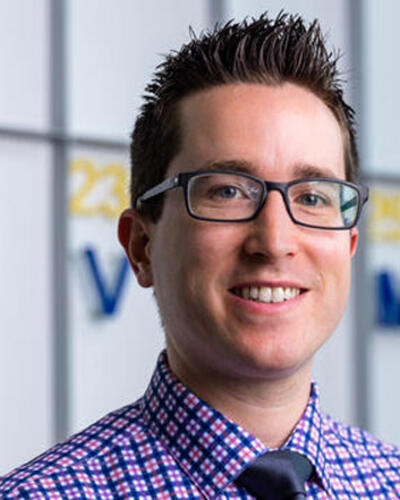Dr. Michael Webb has been a member of the Geneseo faculty since 2022.
Research Interests
Research within the Webb group focuses on the occurrence of metals in medicine as either the therapeutic agent or the target for therapy. Specifically, protein interactions have been observed to be central in either the pathology of several diseases following an interactions with endogenous metal ions, thereby becoming the target for therapy, or in the transportation of metallotherapeutics to their site of action. The projects we are currently investigating are: (1) the use of ruthenium-based therapeutics for the treatment of Alzheimer’s disease, (2) ruthenium complexes as antibacterial agents, and (3) the interactions between metal ions and the Parkinson’s disease protein. For more information on these projects, please visit my personal research webpage: https://webb-lab.weebly.com/

Fall 2025 Office Hours
Wednesday 1:00-2:00pm
Thursday 9:30-10:30am
Fri 10:00-11:00am
or by appointment
Publications
Geneseo Student Co-authors are in bold
12. Hacker, R.M.; Smith, J.J.; Platt, D.C.; Loughlin, M.I.; Grabowski, E.N.; Brennessel, W.W.; Jones, M.A.; Webb, M.I. "A Ru(II)-arene Complex With Phenomental Anti-Aβ Activity" Under Review
11. Murphy, B.J.‡; Bollinger, T.A.‡; Dagar, M.; Hacker, R.M.; Oskard, S.M.; Brennessel, W.W.; Webb, M.I. “Two Perfectly Cromulent Ferrocene Containing Ruthenium(II)-arene Antibacterial Agents” Canadian Journal of Chemistry, 2025, 103, 880-889 (‡ = each author contributed equally to this work).
10. Hacker, R.M.; Smith, J.J.; Platt, D.C.; Jones, M.A.; Brennessel, W.W.; Webb, M.I. “Ruthenium(II)-Arene Complexes with a 2,2'-Bipyridine Ligand as Anti-Aβ Agents” Biomolecules, 2025, 15, 475.
9. Hacker, R.M.; Grimard, D.M.; Morgan, K.A.; Saleh, E.; Wrublik, M.M.; Meiss, C.J.; Kant, C.C.; Jones, M.A.; Brennessel, W.W.; Webb, M.I. "Ru(ii)–arene azole complexes as anti-amyloid-β agents" Dalton Transactions, 2024, 53, 18845-18855.
8. Ehlbeck, J.T.; Grimard, D.M.; Hacker, R.M.; Garcia, J.A.; Wall, B.J.; Bothwell, P.J.; Jones, M.A.; Webb, M.I. "Finding the Best Location: Improving the Anti-Amyloid Ability of Ruthenium(III) Complexes with Pyridine Ligands" Journal of Inorganic Biochemistry, 2024, 250, 112424.
7. Webb, M.I. (2023). The Design of Metal Complexes to Target the Amyloid-β Peptide in Alzheimer's Disease. In Encyclopedia of Inorganic and Bioinorganic Chemistry, R.A. Scott (Ed.).
6. Mensah, S.; Rosenthal, J.D.; Dagar, M.; Brown, T.; Mills, J.J.; Hamaker, C.G; Ferrence, G.M.; Webb, M.I. “A Ru(II)-Arene-Ferrocene Complex With Promising Antibacterial Activity” Dalton Transactions, 2022, 51, 17609-17619.
5. Yawson, G.K.; Will, M.F.; Huffman, S. E.; Strandquist, E.T.; Bothwell, P.J.; Oliver, E.B.; Platt, D.C.; Apuzzo, C.F.; Weitzel, C.S.; Jones, M.A.; Ferrence, G.M.; Hamaker, C.G.; Webb, M.I. “A Dual-Pronged Approach: A Ruthenium(III) Complex That Modulates Amyloid-β Aggregation and Disrupts Its Formed Aggregates” Inorganic Chemistry, 2022, 61, 2733-2744.
4. Meiss, C.J.; Bothwell, P.J.; Webb, M.I. “Ruthenium(II)-Arene Complexes With Chelating Quinoline Ligands As Anti-Amyloid Agents” Canadian Journal of Chemistry, 2022, 100, 18-24.
3. Wall, B.J.‡; Will, M.F.‡; Yawson, G.K.; Bothwell, P.J.; Platt, D.C.; Apuzzo, C.F.; Jones, M.A.; Ferrence, G.M.; Webb, M.I. “The Importance of Hydrogen Bonding: Structure-Activity Relationships of Ruthenium(III) Complexes for Alzheimer’s Disease Therapy with Pyridine-based Ligands” Journal of Medicinal Chemistry, 2021, 64, 10124-10138 (‡ = each author contributed equally to this work)
2. Yawson, G.K.; Huffman, S.E.; Fisher, S.S.; Bothwell, P.J.; Platt, D.C.; Jones, M.A.; Hamaker, C.G.; Ferrence, G.M.; Webb, M.I. “Ruthenium(III) Complexes with Imidazole Ligands That Modulate the Aggregation of the Amyloid-β Peptide Via Hydrophobic Interactions” Journal of Inorganic Biochemistry, 2021, 214, 111303.
1. Huffman, S.E.‡; Yawson, G.K.‡; Fisher, S.S.; Bothwell, P.J.; Platt, D.C.; Jones, M.A.; Hamaker, C.G; Webb, M.I. “Determining Structure Activity Relationships for Ruthenium(III) Complexes Containing Thiazole-based Ligands for Their Ability to Prevent Amyloid-Beta Aggregation” Metallomics, 2020, 12, 491-503. Featured on the back cover. (‡ = each author contributed equally to this work)
Classes
-
CHEM 118: Chemistry II
A continuation of CHEM 116. Topics to be covered include thermodynamics and reaction spontaneity, chemical kinetics, chemical equilibrium, properties of acids and bases, aqueous solution equilibria, electrochemistry, molecular structure and bonding theories, transition metals and their coordination compounds, and chemical properties of selected elements.
-
CHEM 129: Intro to Lab Research in Chem
An introduction to research methods used in chemistry laboratories. Topics include utilizing chemical literature, experimental design and iteration, and scientific communication. Students complete a quantitative analysis project utilizing spectroscopic methods and write a technical report describing their work.
-
CHEM 434: Bioinorganic Chemistry
This course examines the chemistry of inorganic elements in biological systems. Topics include the role of metals in proteins and enzymes, the use of metals in drug catalytic sites or as probes for biomolecular study, metals in migration and direction sensing, minerals in nutrition and toxicity, and the biochemical effects of radioactive elements.
Curriculum Vitae
Education
Postdoctoral Researcher, University of California Berkeley, Berkeley, CA.
Ph.D. Chemistry, Simon Fraser University, Burnaby, BC.
B.Sc. Chemistry (Honours), Mount Allison University, Sackville, NB.